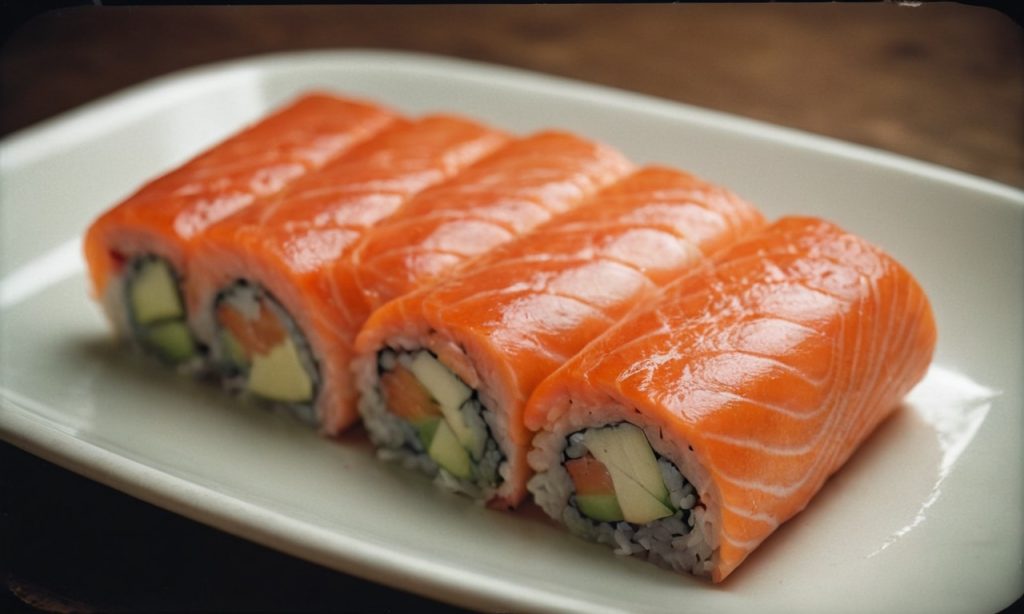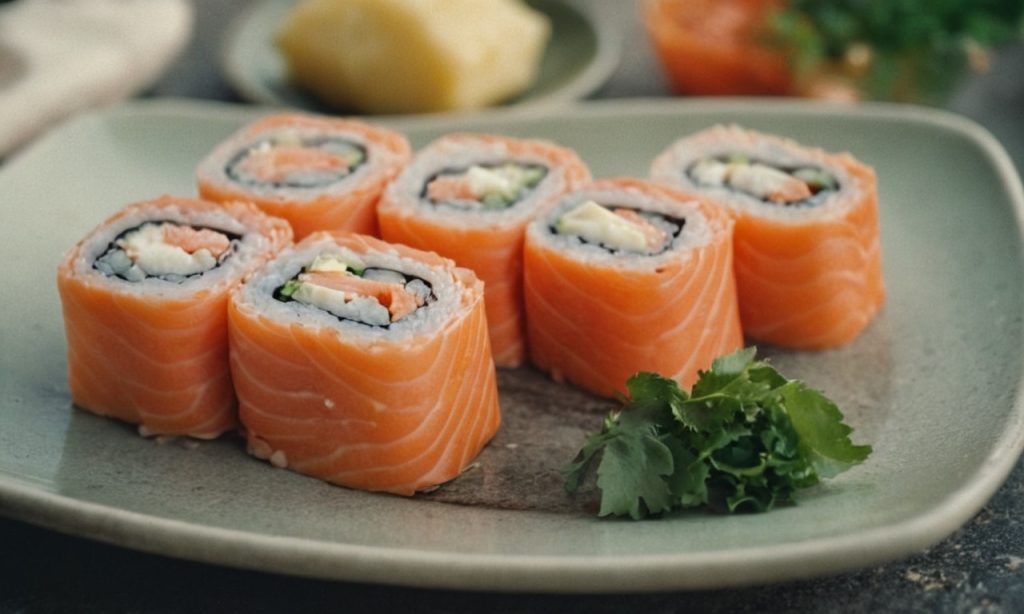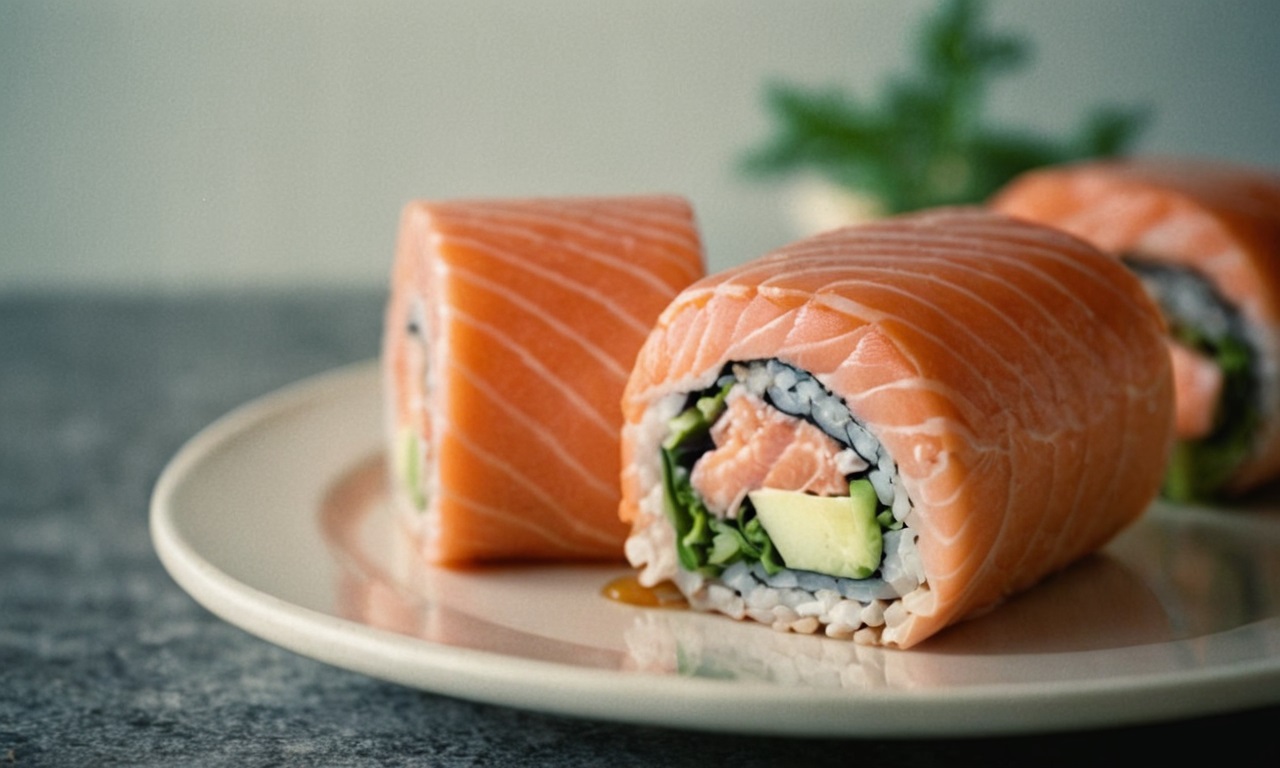Salmon rolls are a delightful culinary creation that tantalize the taste buds with their vibrant flavors and textures. Whether you’re a seasoned sushi aficionado or a curious home cook, this comprehensive guide will equip you with everything you need to know about these delectable delights. We’ll delve into the fascinating world of salmon rolls, exploring their variations, essential ingredients, and the secrets to crafting perfect homemade rolls. So, grab your chopsticks and get ready to embark on a delicious journey!
Unveiling the Secrets of Salmon Rolls (What it is, Popularity, vs Sushi)

What is a Salmon Roll?
At its core, a salmon roll is a type of sushi that features succulent salmon as the star ingredient. It’s typically wrapped in a sheet of crisp seaweed (nori), filled with fluffy sushi rice, and complemented by an array of other flavorful fillings like avocado, cucumber, and creamy sauces. Salmon rolls come in a variety of styles, each offering a unique taste sensation.
Why are Salmon Rolls So Popular?
The popularity of salmon rolls can be attributed to several factors. First and foremost, they’re incredibly delicious! The combination of savory salmon, fluffy rice, and refreshing vegetables creates a harmonious flavor profile that’s sure to please. Additionally, salmon rolls offer a convenient and portable meal option, making them perfect for lunchboxes, picnics, or a quick and satisfying snack. Let’s not forget the health benefits! Salmon is a rich source of omega-3 fatty acids, which are essential for maintaining good heart health.
Salmon Rolls vs. Sushi: What’s the Difference?
While salmon rolls share some similarities with traditional sushi – both utilize seaweed and sushi rice – there are some key distinctions. Traditional sushi can encompass a wider variety of seafood options beyond salmon, and it’s often served in smaller, bite-sized pieces. In contrast, salmon rolls tend to be larger and more generously filled, making them a more substantial meal option.
Exploring the Delights of Salmon Rolls (Types, Ingredients, Building Your Perfect Roll)
A World of Flavor: Unveiling the Different Types of Salmon Rolls
The world of salmon rolls is a vibrant tapestry woven with a multitude of delicious variations. Here, we’ll explore some of the most popular types to tantalize your taste buds:
- The Classic Salmon Roll: This timeless favorite features a delectable combination of Atlantic salmon, refreshing cucumber, creamy avocado, and a touch of zesty mayo for a well-rounded flavor profile.
- Spicy Salmon Roll: Calling all heat seekers! This variation cranks up the flavor with a kick of sriracha mayo and the vibrant pops of masago (capelin roe).
- The Philadelphia Roll with a Salmon Twist: Craving a taste of cream cheese indulgence? The Philadelphia roll, traditionally filled with cream cheese, cucumber, and avocado, gets a delightful makeover with the addition of salmon.
- California Roll Gets a Salmon Upgrade: This popular roll, featuring avocado, cucumber, and imitation crab, takes on a new dimension with the inclusion of salmon.
- Crunchy Salmon Roll: Craving a delightful textural contrast? The crunchy salmon roll features panko-fried salmon, adding a satisfying crunch to the soft and fluffy rice.
- Smoked Salmon Roll: For a touch of sophistication, the smoked salmon roll features the rich smokiness of cured salmon paired with creamy cheese.
- Vegetarian Salmon Roll: Catering to vegetarian preferences, this roll incorporates vibrant vegetables and salmon roe for a burst of flavor and texture.
Building the Perfect Salmon Roll: Essential Ingredients
Now that you’ve explored the diverse landscape of salmon rolls, let’s delve into the essential ingredients that make them sing:
- Seaweed (Nori): The foundation of the roll, high-quality nori should be crisp and have a rich, savory flavor. Opt for whole sheets for rolling or pre-cut squares for ease of use.
- Sushi Rice: The perfect canvas for your salmon roll masterpiece! Sticky sushi rice is key for a cohesive and satisfying roll. We’ll delve deeper into sushi rice preparation techniques in a later section.
- Salmon: The star of the show! Choose fresh, sushi-grade salmon for the best flavor and texture. Opt for different varieties like Atlantic, Sockeye, or King salmon, each offering slightly different taste profiles.
- Fillings: A symphony of flavors awaits! From the refreshing coolness of cucumber and avocado to the creamy indulgence of mayonnaise and vibrant pops of masago, the possibilities are endless.
Crafting Your Salmon Roll Masterpiece: Tips for Building
Before we dive into the step-by-step process of creating your homemade salmon rolls, let’s explore some key techniques for constructing the perfect roll:
- The Mighty Bamboo Mat: Your trusty companion in the salmon roll-making process, the bamboo mat helps you achieve a tight and even roll.
- Distribution is Key: Ensure even distribution of your sushi rice and fillings across the seaweed sheet for a harmonious bite in every mouthful.
Making Salmon Rolls at Home: A Step-by-Step Guide
Now that you’ve been tantalized by the diverse world of salmon rolls and equipped with the knowledge of essential ingredients, it’s time to unleash your inner sushi chef! This step-by-step guide will walk you through the process of creating delectable homemade salmon rolls:
Essential Equipment
Before we embark on our culinary adventure, let’s gather the necessary tools:
- A sturdy cutting board
- A sharp knife (honing your knife beforehand is recommended)
- Mixing bowls for rice and other ingredients
- A bamboo rolling mat (look for one wrapped in plastic wrap for easy cleaning)
- Plastic wrap for handling the rice and shaping the rolls
Crafting the Perfect Sushi Rice:
Sushi rice forms the foundation of your salmon roll. Here’s how to achieve the perfect sticky texture:
- Rinsing the Rice: Rinse your sushi rice in a fine-mesh strainer under cold running water until the water runs clear. This removes excess starch, preventing the rice from becoming mushy.
- Cooking the Rice: Transfer the rinsed rice to a rice cooker or pot and follow the water-to-rice ratio specified on the rice package. Typically, a 1:1 ratio of rice to water is ideal for sushi rice.
- Seasoning the Rice: Once cooked, spread the rice onto a large, shallow dish and gently mix in a seasoned rice vinegar solution. This solution typically comprises rice vinegar, sugar, and salt. Folding the rice with a rice paddle while cooling helps prevent mushiness.
Preparing the Salmon:
The salmon is the star of the show, so ensure it’s fresh and sushi-grade. Here’s how to prepare it for your rolls:
- Safety First: If using raw salmon, ensure it’s frozen at a specific temperature for a designated period to eliminate parasites (consult CDC guidelines for safe handling of raw fish).
- Slicing Techniques: With a sharp knife, thinly slice the salmon against the grain for the most tender texture. Aim for even slices that are slightly wider than the width of your nori sheet.
Preparing the Fillings:
The fillings add vibrant flavors and textures to your salmon rolls. Here’s how to get them ready:
- Chopping Vegetables: Finely julienne your chosen vegetables like cucumber and avocado. Uniformly sized pieces ensure an even distribution in the roll.
- Mixing Sauces: Prepare any sauces you plan to include, such as spicy mayo or a simple sesame oil drizzle.
Assembling Your Masterpiece:
Now comes the exciting part – assembling your salmon roll!
- Prep the Bamboo Mat: Place a sheet of nori on the bamboo mat, rough side facing up.
- Spread the Rice: Using wet hands (to prevent sticking), gently spread a thin and even layer of sushi rice over the nori sheet, leaving a small border uncovered at the top.
- Adding the Fillings: Arrange your chosen fillings (salmon, vegetables, sauces) in a horizontal line slightly above the center of the rice layer.
- Rolling Technique: Using the bamboo mat as a guide, carefully begin to roll the mat away from you, enclosing the fillings in the rice. Apply gentle but firm pressure to ensure a tight roll.
- Sealing the Deal: Moisten the exposed nori border at the top with a little water to seal the roll.
- Perfecting the Shape: Once rolled, gently squeeze the roll to maintain its shape.
Cutting the Roll:
For a clean and professional presentation, here’s how to cut your salmon roll:
- Sharpen Up: Ensure your knife is sharp and dampen the blade with water to prevent sticking.
- Cutting Technique: With a sawing motion, cut the roll into even slices, ideally around 1-2 inches thick.
Congratulations! You’ve successfully crafted a batch of delectable homemade salmon rolls. Enjoy them with your favorite accompaniments like pickled ginger, wasabi, and soy sauce.
Serving Suggestions, Storage, and Variations

Presentation Perfection: Serving Up Your Salmon Rolls
Now that you’ve mastered the art of crafting salmon rolls, let’s explore how to present them like a pro:
- Plating for Perfection: Arrange your salmon roll slices artistically on a plate. Consider adding a dollop of wasabi paste, a sliver of pickled ginger, and a small dish of soy sauce for dipping.
- Accompaniment Symphony: Elevate your salmon roll experience with complementary side dishes. Edamame, seaweed salad, or a bowl of miso soup make perfect accompaniments.
Storing Leftovers: Keeping Your Salmon Rolls Fresh
While salmon rolls are best enjoyed fresh, leftovers can be stored for a limited time. Here’s how to ensure optimal freshness:
- Wrap it Tight: Tightly wrap any leftover salmon rolls in plastic wrap to prevent them from drying out or absorbing unwanted flavors.
- Refrigerate Promptly: Store leftover salmon rolls in the refrigerator for no more than a day. Consume them as soon as possible for the best quality and taste.
Beyond the Basics: Exploring Variations on a Theme
The beauty of salmon rolls lies in their versatility. Here are some ideas to spark your creativity:
- Experiment with Fillings: Don’t be afraid to experiment with different fillings! Explore options like cooked shrimp, mango, or julienned bell peppers.
- Topped Up with Flavor: Elevate your salmon rolls with flavorful toppings like toasted sesame seeds, a drizzle of sriracha mayo, or a sprinkle of furikake (a Japanese rice seasoning).
- Baked or Air-Fried: Craving a warm twist? Consider baking or air-frying your salmon rolls for a delightful textural contrast.
With a little creativity and these handy tips, you can transform your homemade salmon rolls into a culinary masterpiece, enjoyed by you and your loved ones!
FAQs
Salmon rolls have captured the hearts (and stomachs) of many, but there are often lingering questions. This FAQ section aims to shed light on some of the most common inquiries:
Is a Salmon Roll Considered Sushi?
Yes, a salmon roll can be considered a type of sushi. Both utilize sushi rice and seaweed (nori) as core components. However, traditional sushi can encompass a wider variety of seafood options beyond salmon and is often served in smaller, bite-sized pieces. Salmon rolls tend to be larger and more generously filled, making them a more substantial meal option.
Are Salmon Rolls Healthy?
Salmon rolls can be a healthy meal choice, particularly when made with fresh ingredients. Salmon is an excellent source of omega-3 fatty acids, which are essential for maintaining good heart health. Additionally, sushi rice is a good source of carbohydrates, providing energy. However, moderation is key. Be mindful of added sugars and sauces, which can increase the calorie and sodium content. Opting for brown rice for your sushi rice can further enhance the nutritional profile.
Can I Use Cooked Salmon for Salmon Rolls?
Absolutely! While many salmon roll recipes call for raw, sushi-grade salmon, cooked salmon can be a safe and delicious alternative. This is especially beneficial if you’re unsure about the proper handling of raw fish or have concerns about consuming it. Cooked salmon options include baked, poached, or pan-seared varieties. Just ensure the salmon is thoroughly cooked through before incorporating it into your rolls.
Where Can I Buy Salmon Rolls?
Salmon rolls are widely available at various locations:
- Grocery Stores: Many grocery stores offer pre-made sushi options, including salmon rolls. These can be a convenient option for a quick and satisfying meal.
- Sushi Restaurants: Sushi restaurants are the go-to destination for a wider variety of salmon roll choices and the freshest ingredients.
- Online Retailers: Some online retailers offer specialty sushi and sashimi options, including salmon rolls.
Final Thoughts
The world of salmon rolls is a delightful culinary adventure waiting to be explored. With the knowledge you’ve gained from this comprehensive guide, you’re well-equipped to create restaurant-quality salmon rolls at home, experiment with flavors and variations, and enjoy this delicious and versatile dish. So grab your chopsticks, unleash your inner sushi chef, and embark on a delicious salmon roll journey!

